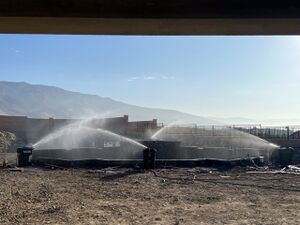Why Should You Water New Gunite or Concrete?
Spraying water on concrete is one of the oldest and best ways to cure concrete.
The chemical reaction that binds the sand and gravel together to form hardened concrete can take up to 28 days to complete.
Concrete curing and hardening is an exothermic chemical process that generates heat. You want concrete to be cured slowly, uniformly, and evenly from top to bottom.
Shotcrete/concrete is ready for water as soon as the initial set is complete, about 4-6 hrs after placement. Water is applied to aid in hydration/curing, a process which decays exponentially, so watering is most critical in the first hours/days after placement.[1]
Concrete will continue to cure/harden forever, but the strength used for design work is the strength after curing for 28 days. This is primarily because it's close to an inflection point in the strength curve with much lower strength gains afterward (and 4 weeks is an easy timeline to use for construction purposes). As the chart shows, the first 7 days are critical for keeping the concrete moist if you want to achieve full 28-day strength.
During the summer months, the outside temperature can become hot. By keeping the surface wet, you are keeping the concrete temperature low. Be sure to start watering the concrete in the morning and keep watering throughout the hottest part of the day. You can use sprinklers on a timer to help with this. Do not start watering during the hottest part of the day because it could shock the concrete into developing surface crazing (similar to a hot glass breaking when filled with cold water).
Spraying water on the surface prevents the concrete slab's surface from drying faster than the bottom.
Finding the Cure is a good article written by a pool professional.
Watering a Finished Surface
With a finished surface, i.e., final decking with no stone going over the top, stay off it the day it is poured. By the next morning, stay off if you can or walk gingerly (no twisting or boots) and keep it wet by misting. If you need to leave, cover with wet burlap, old sheets, towels, etc. You only need to do that for a day or two, after which occasional misting is good for around a week.
Be careful not to cool a finished surface really fast by flooding it if it is dried out and hot from the sun—just mist it to cool it slowly. After it stays wet for an hour or so, you can flood it if that's helpful for keeping it moist. Gentle temperature change allows the cracks to develop more slowly and more likely to follow the intended control joints.
Rapid cooling induces cracks. This is the worst risk when people are advised to mist twice daily. That's way too long between drinks in the sun (for a finished surface) and ineffective if it is concrete that will be surfaced with something else.
Poured concrete (e.g., decking) needs different care because it contains much more water initially. Don't walk on it until about 1.5 days, and be more careful watering it.
Watering a Pool Shell
A pool shell (that will be plastered) and surrounds that will be finished with stone or other material can't be hurt by walking on them the next day. Do not walk down steps or ledges on the same day they were put in, as the pressure of having all of your weight on one foot could cause an imprint.
Gunite/shotcrete is applied much drier than poured concrete. Within a few hours of it being applied, you can literally walk on it. The drier application also gives it much better compressive strength than poured concrete for the same mix. That makes it a little more critical to water it for the first few days.
You can place sprinklers in the gunite shell and let it run for an hour or more a few times daily. You can get timers to help out with this.
American Shotcrete Association recommends a minimum of 7 days of continuous (not just a few times a day) wet curing to help control shrinkage issues, increase strength, and reduce permeability. Surface Saturation Dry is used to describe how to hydrate the shell for the first 7 days minimum to ensure it cures properly.[2]
Proper hydration has a significant impact on the shell and is commonly misunderstood.
How to Water
You can start watering it as soon as the concrete is set enough to walk on (which, with shotcrete, is quick...). Do it several times a day, 3-4 times or more. If it starts to rain, you don't need to add to that. If you are unsure, start early the morning of the day after it is poured.[3]
Avoid shooting a jet stream of water at the concrete at first. It won't matter by the second day after finishing, but contractors don't know how well their customers absorb instructions, so they perhaps find it safer to say 1.5 days.
Your goal for hydration of the shell is Saturated Surface Dry. The surface feels damp, but water does not pick up on your hand. During summer months, this is harder to achieve, and temperatures can reach high enough to deform plumbing pipes. Keeping the shell overhydrated is far better than underhydrated.
How long to Water Concrete?
The most critical time is in the first 3-4 days. There is no reason to water for more than 14 days.
The benefit of keeping concrete from drying too quickly mostly happens at the surface and early curing stages. After the first few days, the surface has settled in, and the rest of the curing goes on deeper, and misting has little to no effect. Misting for longer doesn't hurt anything and can give you something to do while anxiously awaiting the next steps.



